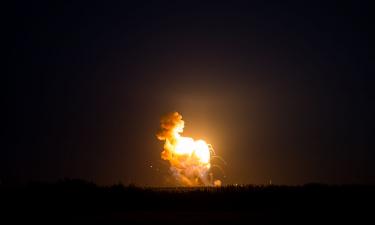Soviet Union paves way for human space flight
Soviet Union surprised the world by putting the first artificial satellite into orbit, then it sent a much bigger satellite carrying a mongrel dog called Laika.

The mission, 50 years ago Saturday, ended sadly but helped pave the way for human flight.
As with other episodes of the Soviet space program, Laika's mission was hidden under a veil of secrecy, and only after the collapse of the Soviet Union could the participants tell the real story behind it.
The satellite that carried Laika into orbit was built in less than one month in what was perhaps the world's fastest-prepared space mission ever.
Excited by the international uproar over the launch of Sputnik on Oct. 4, 1957, Soviet leader Nikita Khrushchev summoned Sergei Korolyov, the father of the Soviet space program, and ordered him to come up with "something new" to celebrate the Nov. 7 anniversary of the 1917 Bolshevik Revolution.
Khrushchev's demand came as a shock even for Korolyov, whose team had managed to put together the first Sputnik in less than three months, said Georgy Grechko, a cosmonaut who started his career as a space engineer.
"We didn't believe that you would outpace the Americans with your satellite, but you did it. Now you should launch something new by Nov. 7," Korolyov quoted Khrushchev as telling him, according to Grechko.
Boris Chertok, Korolyov's right-hand man, said the short notice made it impossible to design an entire new spacecraft, but there was also little sense in simply repeating the Sputnik launch.
So when someone on Korolyov's team suggested putting a dog into orbit, he jumped at the idea.
Little was known about the impact of space flight on living things, and some believed they would be unable to survive the launch or the conditions of outer space.
The Soviet Union had experimented with launching dogs on short suborbital missions during ballistic missile tests, and some of them survived several such missions. All of them were stray mongrel dogs - doctors believed they were able to adapt quicker to harsh conditions - and all were small so they could fit into the tiny capsules.
Just nine days before the launch, Dr. Vladimir Yazdovsky chose one of them - 2-year-old Laika - for the mission.
Stories about how she was chosen vary: Some say Laika was chosen for her good looks - a Soviet space pioneer had to be photogenic. Others say the top choice for the mission was dropped because doctors took pity on her: Since there was no way to design a re-entry vehicle in time for the launch, the glory of making space history also meant a certain death.
"Laika was quiet and charming," Yazdovsky wrote in his book chronicling the story of Soviet space medicine.He recalled that before heading to the launch pad, he took the dog home to play with his children.
"I wanted to do something nice for her: She had so little time left to live," Yazdovsky said.
Working round-the-clock, Korolyov and his team combined a capsule that would carry the dog with basic life-support systems with elements of the first Sputnik. They decided not to separate the satellite from the booster's second stage to simplify the design.
They worked without blueprints at a pace that was outstanding even at the time of the space race and seems utterly impossible by today's standards.
"Now when we have computers, sophisticated industrial equipment, lasers and other things, no one is capable of making a new satellite in just one month," Grechko said in an interview.
"Now it would take a month just to start doing the paperwork. Korolyov told us later that it was the happiest month of his life," he said.
Due to last-minute technical problems, Laika had to wait for the launch in the cabin for three days. Temperatures were low, and workers heated the cockpit through a hose.
On Nov. 3, Laika blasted off into space in Sputnik 2, which weighed 508 kilograms (1,118 pounds) - a show of Soviet ability to take big payloads into space.
Sputnik 1 weighed just 83.6 kilograms (184 pounds), while the first U.S. satellite, Explorer 1, launched on Jan. 31, 1958, weighed 14 kilograms (about 31 pounds).
When Laika reached orbit, doctors found with relief that her heart beat, which had risen on launch, and blood pressure were normal. She ate specially prepared food from a container.
According to official Soviet reports, the dog was euthanized after a week. Laika's mission drew a wave of protests from animal protection activists in the West.
It wasn't until after the Soviet collapse, that some participants in the project told the true story: Laika indeed was to be euthanized with a programmed injection, but she apparently died of overheating after only a few hours in orbit.
There was no information to indicate exactly when she died.
"It was impossible to build reliable life-support and thermal-control systems in such a short time," Chertok wrote in his memoirs.
Several other dogs died in failed launches before the successful space flight - and safe return to Earth - of the dogs Belka and Strelka in August 1960.
After a few other flights with dogs, the Soviet Union put the world's first human - Yuri Gagarin - into space on April 12, 1961.
Gagarin - known for his wry sense of humor - is said to have joked: "I still don't understand who I am: the first human or the last dog in space."
Subscribe to Pravda.Ru Telegram channel, Facebook, RSS!





